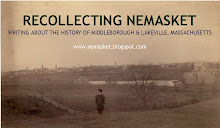.
An important feature of the Green School, as with all schoolhouses was the surrounding schoolyard which provided not only a recreational space for children, but also a location for sanitary facilities and a woodhouse.
While a fence was originally built in 1871 when the school was built, in 1878, either a new fence or an addition to the existing fence was erected about the Green School yard with J. K. & B. Sears of Middleborough being paid $6.63 for lumber, and E. B. Elmes $5.63 for building it. Schoolyard improvements continued the following year (1879) during which James Sparrow was paid $1.00 for grading the yard which was described as “large” and “well-fenced” in 1881. Despite its size, the Green School yard was nonetheless somewhat barren. In April, 1904, undoubtedly as part of Arbor Day exercises, trees were purchased through the contributions of the pupils and planted in the school yard under the supervision of Tree Warden Bailey. Increasing motor traffic in the second quarter of the twentieth century led to the posting of "Warning" signs along the approaches to the school in the summer of 1935.
Located within the school yard were sanitary facilities which were provided in the form of an outhouse. While there is no specific mention of a separate outhouse, a “commodious wood-house” is mentioned as standing in the schoolyard in 1881. This may have, in fact, included sanitary facilities as was sometimes common. School outhouses tended to be subject to vandalism on the part of some students. In 1885, the interiors of the outhouses at several Middleborough schools (though not the Green), were described as “shockingly marked and cut, each year adding something to that of the year before, till they now are unfit for use.” Like other school property, the prevention of damage to these structures was added to the burdens of the school teacher. In 1911, Superintendent Bates recommended the construction of privy vaults for these outbuildings which, in time, were replaced by indoor bathrooms.
Typically, male students were assigned responsibilities for wood and water. Water for the Green School was obtained from either the Church of the Green or from “agreeable neighbors”, and carried in a pail by students across the road. With the designation of Plympton Street as Route 44, traffic volume through the area increased and made such a task potentially hazardous. Not until 1936 was the school provided with running water following the extension of a town water line beyond the school which made a connection with the school feasible. During the summer of 1936, the school was connected and cisterns dug to accommodate waste from the sink. “The installation of this water aids greatly to the convenience and health of the children attending the school.”
To care for the school property, janitors were engaged, though somewhat haphazardly during the early years of the school's existence. In the 1870s and 1880s, the chore appears to have been carried out by younger boys and during the school’s first year of operation, Willie Bryant was paid $3.00 for regularly cleaning the building. In 1907, the janitor responsible for cleaning the Green School was paid $14.75 for the year. Later, Edward Buchanan was paid $2.50 per week for maintaining the Green School in 1930. Edward W. Fessenden served as the school’s last janitor from 1936 until its closure in June, 1941.
Besides the regular janitorial service the building received, once a year it was thoroughly scrubbed, typically in late summer in preparation for the school year. While neighbors looking to supplement their income generally took on the task, in rare instances a teacher might perform the work. In 1889, teacher Mary E. Deane at the Green was paid $2.00 for cleaning the school, a singular mark of devotion on her part.
PREVIOUS PAGE: Repairs & Renovation
Subscribe to:
Post Comments (Atom)













+-+Copy.jpg)

+of+Smoky+Mountains+018.jpg)
No comments:
Post a Comment